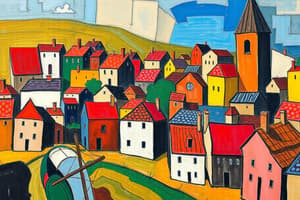Podcast
Questions and Answers
What was a primary characteristic that distinguished medieval towns from manor villages?
What was a primary characteristic that distinguished medieval towns from manor villages?
- Towns had larger populations than villages.
- Towns were governed by lords unlike manor villages.
- Towns were home to tradespeople while villages were primarily serf-based. (correct)
- Towns had strict agricultural practices unlike villages.
Which group of tradespeople would most likely need to be near a water source?
Which group of tradespeople would most likely need to be near a water source?
- Bakers
- Carpenters
- Goldsmiths
- Brewers (correct)
How were guilds significant to the trades in medieval towns?
How were guilds significant to the trades in medieval towns?
- Guilds restricted women from participating in trades.
- Guilds established rules and guidelines to ensure skill proficiency. (correct)
- Guilds eliminated the need for apprenticeship programs.
- Guilds created opportunities for apprentices to own businesses immediately.
What was the typical pathway for a young person to become a master in a trade?
What was the typical pathway for a young person to become a master in a trade?
In the governance of medieval towns, which of the following statements is true?
In the governance of medieval towns, which of the following statements is true?
What was the most common way for women to gain business ownership during the medieval period?
What was the most common way for women to gain business ownership during the medieval period?
Why might tradespeople gravitate towards larger towns?
Why might tradespeople gravitate towards larger towns?
What role did apprentices typically hold during their training in a guild?
What role did apprentices typically hold during their training in a guild?
What was a key feature of the economic structure of medieval towns?
What was a key feature of the economic structure of medieval towns?
Which tradesperson was likely to work with fabric in medieval towns?
Which tradesperson was likely to work with fabric in medieval towns?
Flashcards are hidden until you start studying
Study Notes
Growth of Medieval Towns
- Medieval towns grew steadily between 1000 and 1300 CE, differing significantly from manor villages populated mainly by serfs.
- Towns featured a diverse population of tradespeople including blacksmiths, bakers, brewers, weavers, and carpenters.
- Larger towns like London and Paris had specialized trades such as goldsmiths, cloth dyers, and tailors, which contributed to the economy.
Trade and Guilds
- Proximity to other practitioners was crucial for tradespeople, often influenced by the town's layout and natural resources.
- Brewers specifically needed access to quality water sources for ale production.
- By the twelfth century CE, many tradespeople organized into guilds to establish industry standards and craft mastery.
- Apprenticeships were a common pathway into trades, requiring years of training and a final product meeting guild standards.
Role of Women in Trade
- Women were allowed to join guilds and run businesses, often inheriting them from family members.
- Business ownership for women primarily came through inheritance rather than independent establishment.
Governance and Autonomy
- Lords technically owned many towns but rarely took an active role in governance.
- Town governance was typically conducted by guild masters, with qualifications in some towns enabling only masters to elect officials.
- Despite some independence from aristocratic control, governance was still largely held by wealthy townspeople.
- Wealthy towns could buy their freedom from lords, becoming autonomous.
- Serfs who escaped to free towns gained permanent freedom after living there for a year and a day undetected.
Studying That Suits You
Use AI to generate personalized quizzes and flashcards to suit your learning preferences.




